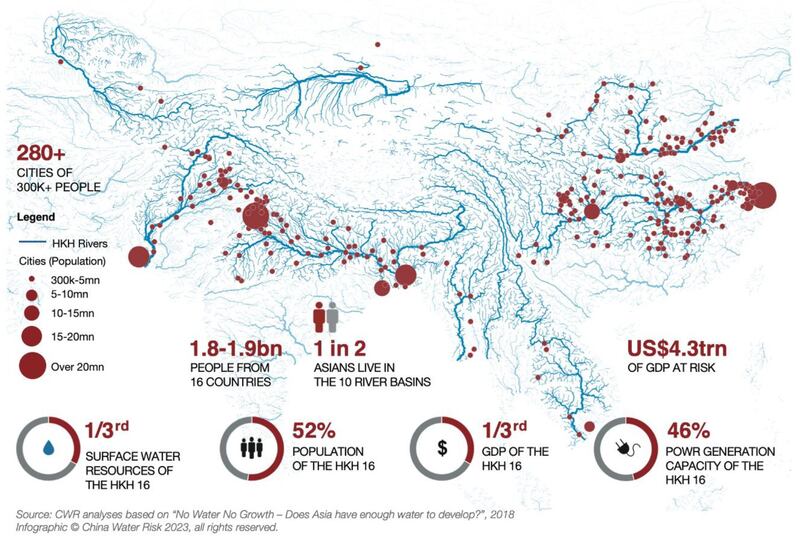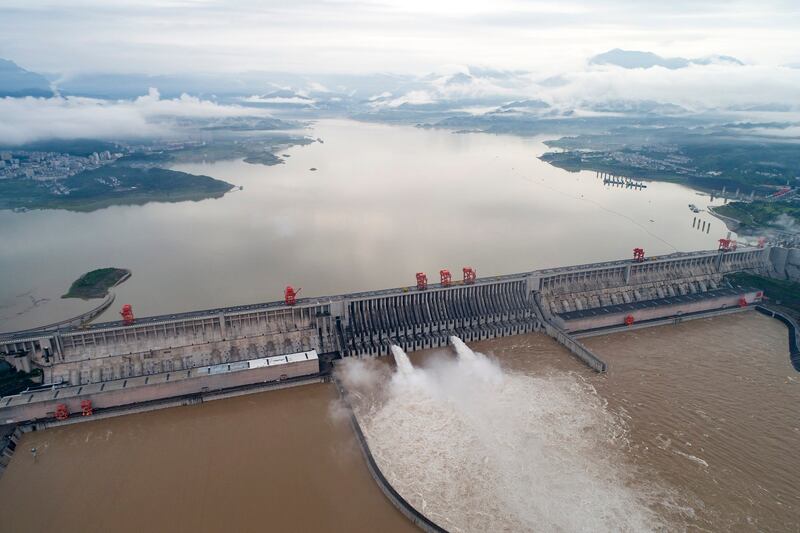Asia’s 10 major river systems -- that play a vital role in the economies and energy security of 16 countries -- are facing significant disruptions due to climate change, a new report warns, calling for urgent action to safeguard regional water flow.
The basins of the 10 rivers originating from the Hindu Kush-Himalayan water towers are inhabited by 1.9 billion people and contribute U.S.$4.3 trillion to annual gross domestic product, said the report "No River, No Power" by China Water Risk (CWR), a non-profit think tank based in Hong Kong.
The climate change risk means up to one in two Asians could be affected by increasing water scarcity due to accelerated glacial melt, reduced snowfall, changing monsoon patterns and overexploitation of groundwater resources, the report released Wednesday said.
Asia gets most of its water from the Himalayas, Hindu Kush, Karakorum mountains, and the Tibetan Plateau. Collectively, they are often called the “Third Pole” or “Asia’s Water Towers,” making up 10 major river basins.
These include the Amu Darya, Brahmaputra, Ganges, Indus, Ayeyarwady, Mekong, Salween, Tarim, Yangtze and Yellow rivers. They flow through 16 countries, including China and most of Central, South, and Southeast Asia before reaching the seas or ending in a desert.
Known as the continent’s cradles of civilization, they are also responsible for almost three quarters of global rice production.

The report said that most of the countries are developing, which means more people will flock to more than 280 large cities along the rivers, adding pressure to already stressed systems.
According to the report’s projection, all rivers face escalating and compounding water risks due to climate change, with four of the 10 rivers seeing an overall decrease in river flows by 2050 if the earth heats by the 1.5 to 2 degrees Celsius threshold set by Paris climate agreement.
Such impacts will affect the 10 river systems’ power generation, currently responsible for 865 gigawatts (GW), or 46% of the total electricity capacity in the 16 countries, the report said. It is more than the combined capacity of Brazil, Canada, Germany, Japan and Russia.
Over 94% of this installed capacity (865GW) needs water to generate electricity, with coal and hydropower making up most of the share, while more than a third already lie in river basin areas that face “High” to “Extremely High” water stress or are in arid regions.
“Uncertain future flows of the 10 rivers and extreme weather mean we must curate mountains-to-oceans waternomic roadmaps and energy systems that are resilient to climate change,” said Debra Tan, head of the think tank and lead author of the report.
“National energy and water security plans must thus dovetail. The need to do all this is ever more urgent as doing so will help us manage escalating and compounding water risks as well as meet rising demand for water.”
Laos, Cambodia and Myanmar highest-risk countries
According to the report, landlocked Laos is the most exposed among the risk groups, along with Myanmar and Cambodia in the overall high-risk group, while China is considered a mid-high risk and Vietnam low risk.
In Laos, the Mekong accounts for two-thirds of its surface water and houses over 90% of its population and gross domestic product, according to the report, with almost 100% of Laos’s national installed capacity on the Mekong.
Similarly, Cambodia receives 26% of its surface water from the Mekong, home to 79% of its population and 85% of its GDP. Around two-thirds of Cambodia’s national installed capacity as hydropower sits in the Mekong river basin.
In Myanmar, the Ayeyarwady, Salween, and Mekong provide 35% of the country’s surface water and house 58% of its population and contribute 46% to its GDP. Almost two-thirds of its installed power capacity is on the Ayeyarwady and one-third on the Salween.
The report also noted that a surge in “just-in-case” coal-fired power additions in China after the severe droughts along the Yangtze in 2022 is just one of many cascading effects of climate change impacts.
Out of the 10 rivers, only Amu Darya does not flow through China. The other nine rivers provide half of China’s surface water, support about 44% of its population, and contribute about 30% to its GDP.
China has around half of its national power dispersed among seven rivers, with the lion’s share in the Yangtze and Yellow river basins.

The Asia-Pacific is home to 80% of global coal generation, while power sector emissions in the region make up 62% of the total worldwide.
Asia’s heavy reliance on still expanding coal-fired power fleet only accelerates climate change and exacerbates water scarcity, the report said, warning that such power generation requires water for cooling and driving steam turbines, making energy security even more vulnerable during a water crisis.
The transboundary nature of the river systems also adds to the risk, it said, giving an example of the Mekong that flows through five countries.
“This means that the transboundary management of eight out of the 10 rivers should not just be about water sharing but also energy policies and development as well,” said CT Low, CWR’s geospatial risk lead and coauthor of the report.
Edited by Mike Firn.
